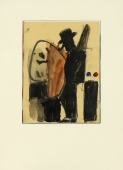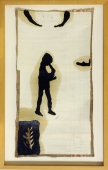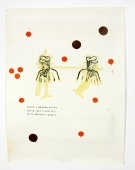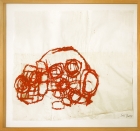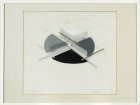
Artist | Alex Katz (*1927)
https://www.artist-info.com/artist/Alex-Katz
 Artist Portfolio Catalog
Artist Portfolio Catalog
| Image | Artist | Title | Year | Material | Measurement | ||||||||||||||||||||
|---|---|---|---|---|---|---|---|---|---|---|---|---|---|---|---|---|---|---|---|---|---|---|---|---|---|
 |
Alex Katz | The Red Smile | 1963 | oil on canvas | 200 x 291,5 cm | ||||||||||||||||||||

Alex Katz (*1927)The Red Smile
|
|||||||||||||||||||||||||
About the work (english)
About the work (english)
In the Museum für Moderne Kunst, Frankfurt am Main central hall a comprehensive group of works by Alex Katz will be installed as the beginning and as the end of the exhibition. They present an image of human kind in the form of large-size portraits in a very idiosyncratic and "American" way. From the Whitney Museums collection, the pictures The Red Smile, made in 1963, and Place, made in 1977, have made their way to Frankfurt, and they have been supplemented from the artist's own collection by Belinda Smiles, produced in 1993, Ahn Smiles, Jessica Smiles and Kathryn Smiles, all painted in 1994.
Katz started painting in the Fifties and became one of the most important painters in American Pop Art, but his, oeuvre has to date not received the exposure it deserves in Germany and Europe. The perception of the objective facts of life rests in his opinion on moments of feeling, of energy and of light. And in his paintings he combines these elements in an exceptionally expressive manner. In a critical appraisal of Manet and Matisse, Katz recognized the significance of light and color when it came to giving a portrait a clear, unequivocal, flat and direct impact on the viewer. By concerning himself with Picassos oeuvre, he developed a sensitivity for figurative abstraction. Katz paintings are not reales in the traditional sense, but are painted in a form of realism that depended on subjective perception and drew its strength from a representative form of expression. In the early Sixties, Katz increasingly focused on the techniques and idioms of billboard advertising and film, In both media, and they were becoming ever more dominant in modern society, he came across forms of language and expression that continue to influence his style today: extreme blow-ups of motifs to render them more clear, the concentration on silhouette for a face or an object taken as motif, the overlapping of motifs to strengthen the visual effect. He developed this approach quite consistently, initially isolating the figure and then the portrait within the picture. At the same time the scale of the pictures grew - large-format paintings were the result, as they enabled Katz to avoid presenting the individual, the specific qualities in people's faces and instead depict a certain form of "universality' in human beings, something that could only be achieved using abstractness, brought to bear here with great subtlety. All these elements are given a voice in Katz' own style in the two large-sized pictures The Red Smile and Place. In The Red Smile our gaze alights on the three-quarters portrait of Ada, Katzs wife, painted against a monochrom red background. The painting seems to be the product of swift but precise strokes. Physiognomic details, hair and items of clothing are spread out across the picture's surface, so that the result is a picture of a portrait, as opposed to a portrait. Here, Katz uses painting as a means of expression that transforms the individual into a representative, generalized, impersonal "model" of the human being at a specific time. All the details have been stylized. The smile becomes a stereotype gesture that stands for the positivist outlook on society. In terms of connotations, the lips with their red color are supported by the red background. Erotic aura becomes exaggerated as a stylized, representative gesture and thus points to the structures of communication in the US in the Sixties, which were based on specific preset types of behavior.
In Place, we encounter portraits of actors brought together in a group that can hardly be grasped in spatial terms and has been simply distributed across the surface of the canvas. Katz used movie stills as the motifs, merging them into a collage of generalized faces that lack any depth and are typical for the idiom of film.
The exhibition in Frankfurt contains four large-size portraits from the Smiles series. They re-define the issue of what goes to make an individual and how an individual should be represented or should represent him or herself. The smiling portraits of Belinda, Ahn, Jessica, and Kathryn have been painted on a darkgray background. The faces are smooth, lacking in depth and painted as though they had been Cut out. The different types of women are solely differentiated in terms of hair style, as well as the color and shape of their faces and thus identifiable as individuals. The smiles which link the portraits to each other, depicted in terms of a stereotype expression, turn the faces into pre-set types for a notion of standardized human being or even of human types. Here, Katz shows humans in the form of portraits such that they leave an artistic, representative impression on the viewer without in any way revealing anything about the private sphere of the people portrayed.
About the work (deutsch)
About the work (deutsch)
In der zentralen Halle des Museums für Moderne Kunst Frankfurt am Main wurde als Beginn, aber auch als Ende der Ausstellung eine umfangreiche Gruppe von Werken des Malers Alex Katz installiert, die das Bild des Menschen in Form von großformatigen Porträts auf eine sehr eigene, amerikanische Art und Weise thematisiert. Aus der Sammlung des Whitney Museums konnten die Bilder The Red Smile (1963) und Place (1977) nach Frankfurt gebracht werden, aus der Sammlung des Künstlers erhielten wir zusätzlich die Arbeiten Belinda Smiles (1993), Ahn Smiles, Jessica Smiles und Kathryn Smiles (alle von 1994).
Katz, der in den fünfziger Jahren mit der Malerei begann, kann als einer der wichtigsten Maler aus dem Umkreis der amerikanischen Pop Art bezeichnet werden, auch wenn sein Werk in Deutschland und Europa bisher nur unzureichend bekannt gemacht wurde. Mit seinen, der eigenen Lebenswelt oder dem Film entnommenen Motiven, entwickelte er einen sehr persönlichen Stil, für den eine repräsentative ,Zur-Schau-Stellung' der menschlichen Figur, des Porträts, vor einer abstrahierten Landschaft oder einem monochromen Bildgrund, charakteristisch ist. Die Wahrnehmung des Lebens basiert für Katz vor allem auf den Manifestationen der Empfindungen, der Energie und des Lichts; und genau diese sind in seinen Bildern in einer außergewöhnlichen Ausdrucksdichte verbunden. In der Auseinandersetzung mit Werken von Manet und Matisse erkannte Katz die Bedeutung von Licht und Farbe, um ein Porträt klar, eindeutig, flächig und direkt wirken zu lassen. Durch die Beschäftigung mit den Werken Picassos entwickelte er eine Sensibilität für Fragen der figürlichen Abstraktion. In den frühen sechziger Jahren beschäftigte er sich verstärkt mit den Techniken und der Sprache der Plakatwerbung und des Films. In beiden, für die moderne Gesellschaft immer dominanter werdenden Medien, fand er Ausdrucksformen, die seinen Stil bis heute mitgeprägt haben: Die extreme Vergrößerung von Motiven zu ihrer Verdeutlichung, die scherenschnittartige Konzentration auf ein Gesicht oder Gegenstandsmotiv und die Überschneidung von Motiven zur Verstärkung der optischen Wirksamkeit. Seine Bilder sind damit nicht im traditionellen Sinn realistisch, sondern formulieren vielmehr einen von der subjektiven Wahrnehmung abhängigen, vor allem auf repräsentative Wirkungen hin zielenden Realismus. In einer konsequenten Entwicklung isolierte er dafür zunächst die Figur, dann das Porträt im Bild. Gleichzeitig steigerte Katz den Maßstab der Bilder zu einer großformatigen Malerei, die ihm die Möglichkeit bot, nicht das Individuelle ‘Einmalige’ aus den Gesichtern von Menschen herauszulesen und zu gestalten, sondern das ‘Allgemeine’ im Menschen festzuhalten und auf die Leinwand zu bannen. Alle genannten Charakteristika werden in den beiden großformatigen Bildern The Red Smile und Place deutlich. The Red Smile zeigt das in Dreiviertelansicht gemalte Porträt seiner Frau Ada, vor einem monochromen roten Hintergrund. Die Malerei wirkt flüchtig und dennoch präzis. Physiognomische Details, Haare und Kleidungsstücke erscheinen in die Fläche gebreitet, so daß das Bild eines Porträts, nicht ein Porträt entsteht. Das Individuum wird zu einem unpersönlichen verallgemeinernd die Gegenwart repräsentierenden Modell vom Menschen. Das Lachen wirkt stereotyp und weist auf das positivistische Denken der Gesellschaft hin. Die rot gefärbten Lippen finden in dem roten Bildhintergrund eine Entsprechung. Erotische Ausstrahlung wird zur stilisierten, repräsentativen Geste und versinnbildlicht somit die Verhaltensschemen und Kommunikationsstrukturen der amerikanischen Gesellschaft der sechziger Jahre. In Place sind Porträts von Schauspielern zu einer räumlich kaum nachzuvollziehbar über die Bildfläche verteilten Gruppe zusammengeschlossen. Katz entnahm seine Motive hier den Stills verschiedener Filme und schuf so eine Collage verfluchter und für die Sprache des Films dieser Zeit allgemein typischer Gesichter.
Die vier großformatigen Porträts aus der Serie der Smiles definieren die Frage nach dem Individuum, nach seiner Selbstdarstellung und der Möglichkeit seiner repräsentativen Darstellung abermals. Auf dunkelgrauen Bildhintergrund sind die lächelnden Porträts von Belinda, Ahn, Jessica und Kathryn als glatte, flache Gesichter wie ausgeschnitten gemalt. Die unterschiedlichen Frauentypen sind allein durch Frisur, Gesichtsschnitt und Gesichtsfarbe differenziert und als Individuen voneinander abgehoben. Das alle Porträts verbindende, stereotype Lächeln vereinheitlicht die Gesichter zu Schemen einer Vorstellung von Menschen oder bestimmten Menschentypen. Katz Menschenbilder wirken auf den Betrachter als repräsentative, eindrucksvolle Gestaltungen, geben jedoch in keinem Fall etwas von der Privatheit der porträtierten Personen preis.
German text by Rolf Lauter / Translation by Jeremy Gaines
(Extract - Full printed version available in the Museum)
MMK - Museum für Moderne Kunst, Frankfurt am Main
Internet
Internet
 Exhibition Announcements Exhibition Announcements 
| Learn more about this service |
|---|
 offers / Requests offers / Requests  |
Learn more about this service |
|---|
 Visualization |
Learn more about this service | ||
|---|---|---|---|

Interested in discovering more of this artist's networks?
3 easy steps: Register, buy a package for a visualization, select the artist.
See examples how visualization looks like for an artist, a curator, or an exhibition place: Gallery, museum, non-profit place, or collector.

Exhibition History

|
SUMMARY based on artist-info records. More details and Visualizing Art Networks on demand. Venue types: Gallery / Museum / Non-Profit / Collector |
||||||||||||
| Exhibitions in artist-info | 227 (S 89/ G 138) |
Did show together with - Top 5 of 2085 artists (no. of shows) - all shows - Top 100
|
||||||||||
| Exhibitions by type | 227: 120 / 69 / 33 / 5 | |||||||||||
| Venues by type | 153: 74 / 52 / 23 / 4 | |||||||||||
| Curators | 54 | |||||||||||
| artist-info records | Jun 1949 - Sep 2026 | |||||||||||
|
Countries - Top 5 of 15 United States (118) Germany (51) United Kingdom (18) Switzerland (6) France (5) |
Cities - Top 5 of 78 New York (68) London (16) Frankfurt am Main (12) Berlin (9) Madison (ME) (9) |
Venues (no. of shows )
Top 5 of 153
|
||||||||||
Curators (no. of shows)
Top 5 of 54
|
| Kunsthalle Tübingen | S | Mar 2026 - Sep 2026 | Tübingen | (142) | +0 | |
| Fritz, Nicole (Curator) | +0 | |||||
| Galerie Thomas | G | Apr 2024 - Sep 2024 | München | (36) | +0 | |
| Museum Frieder Burda | G | Dec 2022 - Apr 2023 | Baden-Baden | (31) | +0 | |
| Whitney Museum of American Art | G | Mar 2019 - Aug 2019 | New York | (365) | +0 | |
| Breslin, David (Curator) | +0 | |||||
| Kross, Margaret (Curator) | +0 | |||||
| Whitechapel Gallery | G | Aug 2017 - Nov 2017 | London | (417) | +0 | |
| Galerie Ropac - Paris Marais | S | Aug 2016 - Oct 2016 | Paris | (106) | +0 | |













